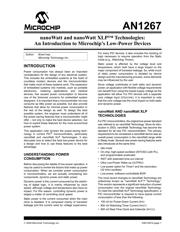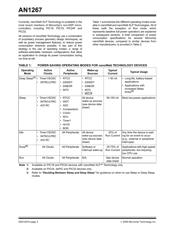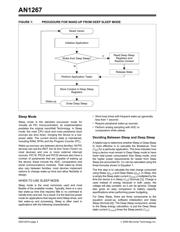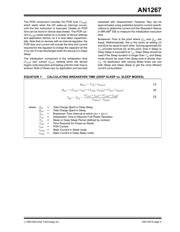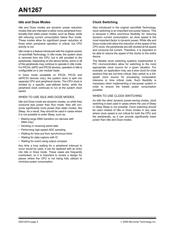下载

© 2009 Microchip Technology Inc. DS01267A-page 1
AN1267
INTRODUCTION
Power consumption has always been an important
consideration for the design of any electrical system.
This includes the embedded systems at the heart of
countless modern devices and the microcontrollers
that make most of these systems work. The expansion
of embedded systems into markets, such as portable
electronics, metering applications and medical
devices, has caused power consumption to become
one of the foremost concerns for embedded system
designers. It is important that a microcontroller not only
consume as little power as possible, but also provide
features that allow for minimal power consumption in
the rest of the design as well. To design the best
possible system, the engineer must understand all of
the power-saving features that a microcontroller might
offer – not only to make the best device selection, but
how to exploit these features for the most economical
power system.
This application note reviews the power-saving tech-
nology in current PIC
®
microcontrollers, particularly
nanoWatt and nanoWatt XLP Technologies. It also
discusses how to select the best low-power device for
a design and how to use these features to the best
advantage.
UNDERSTANDING POWER
CONSUMPTION
Before discussing the details of low-power operation, it
may be useful to review the factors that make up power
consumption. When we consider power consumption
in microcontrollers, we are actually considering two
components: dynamic power and static power.
Dynamic power is the current consumed by the switch-
ing of digital logic. It is mainly influenced by clock
speed, although voltage and temperature also have an
impact. For this reason, controlling dynamic power is
largely a matter of controlling clock speed.
Static power is the current consumed when the main
clock is disabled. It is composed mainly of transistor
leakage and the current used by voltage supervisors.
For many PIC devices, it also includes the clocking of
logic necessary to resume operation from the Static
mode (e.g., Watchdog Timers).
Static power is affected by the voltage level and
temperature, which both have a large impact on the
major component of transistor leakage. So, while much
of static power consumption is dictated by device
design and the manufacturing process, some elements
may be influenced by the user.
Since voltage contributes to both static and dynamic
power, an application with flexible voltage requirements
can benefit from using the lowest supply voltage as the
application will allow. For PIC devices with a separate
core voltage input (V
DDCORE), it is important to note
that the core voltage has the most impact on both static
and dynamic power.
nanoWatt AND nanoWatt XLP
TECHNOLOGIES
For PIC microcontrollers, the original low-power standard
was referred to as nanoWatt Technology. Since its intro-
duction in 2003, nanoWatt Technology has become the
standard for all new PIC microcontrollers. The primary
requirement to be considered a nanoWatt device was an
overall power consumption in the nanoWatt range while
in Sleep mode. Several new power-saving features were
also introduced at the same time:
• Idle mode
• On-chip, high-speed oscillator (INTOSC) with PLL
and programmable postscaler
• WDT with extended time-out interval
• Ultra Low-Power Wake-up (ULPWU)
• Low-power option for Timer1 and the secondary
(32 kHz) oscillator
• Low-power, software-controllable BOR
The most recent changes to nanoWatt Technology are
collectively known as “nanoWatt XLP™ Technology”.
This version represents a significant reduction of power
consumption over the original nanoWatt Technology.
To meet the nanoWatt XLP Technology specification, a
PIC microcontroller is required to have typical current
consumption of less than the following:
• 100 nA for Power-Down Current (I
PD)
• 800 nA Watchdog Timer Current (IWDT)
• 800 nA Real-Time Clock and Calendar (I
RTCC)
Author: Brant Ivey
Microchip Technology Inc.
nanoWatt and nanoWatt XLP™ Technologies:
An Introduction to Microchip’s Low-Power Devices


